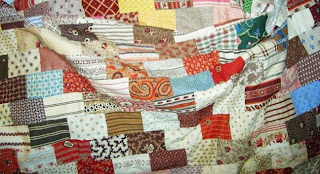Top reported to have 1,676 pieces
In 1879, 21-year-old Hattie Sprague was busy at her sewing machine.
She entered numerous items At Sacramento 's California State Fair in September:
- Two Java canvas tidies
- Silk Embroidered picture
- Dozen linen handkerchiefs
- Two pieces of linen needlework
- Patchwork quilt, machine quilted
- Charm quilt, machine worked
Anonymous woman at a machine after 1860
For those who are not familiar with a charm quilt the Sacramento Union described it well in their account of the fair's needlework:
"Charm quilt, Miss Hattie E. Sprague, 1,053 pieces, no two alike."
The description is exactly what we think of as a charm quilt 120 years later.
Detail of a charm quilt from the Pat Nickols collection
at the Mingei Museum, California
Many pieces, no two alike.
We assume Hattie's quilt was made of a single template, but have no idea what it actually looked like.
Triangles?
Tumblers?
Charm quilts above are from the Pat Nickols collection.
I was hoping to find a picture of Hattie or her quilts but no such luck. I did find that she was California-born in 1858. Her parents Moses and Nancy Sprague came to Sacramento right after the gold rush and prospered as farmers, settling on land in "New Helvetia" the old Sutter land grant..
Hattie probably made her quilt at her father's Sacramento farm house,
which she eventually inherited.
The address today would be the 2100 block of Fourth Avenue.
Four years after Hattie finished her charm quilt she married Hugh C. Jones in November, 1883. After being widowed she married Benjamin Franklin Walton, a Pennsylvanian who'd come to California in 1859. The second marriage took place in 1895.
During the early 20th century Hattie Walton went to court to obtain the family farm, which her mother's executors hoped to divert to other relatives. She won the land, which she sold to developers of Curtis Park in 1909.
She died on July 4, 1936. I could find no records of any descendants.
Hexagon charm quilt
A whole lot of half-square triangles.
Very few quilters achieved the goal of no two pieces alike.










